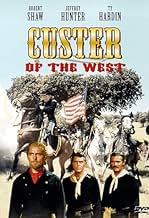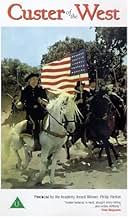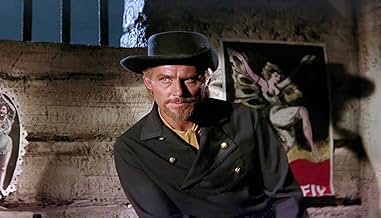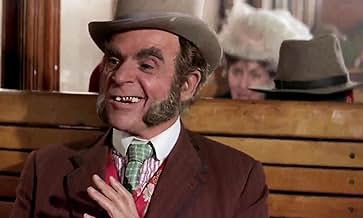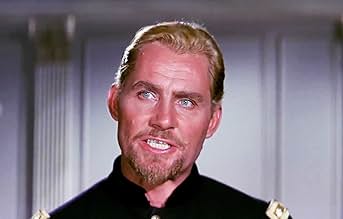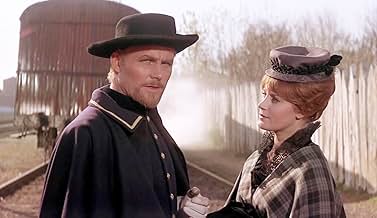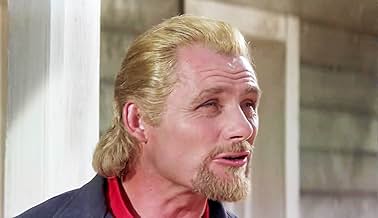CALIFICACIÓN DE IMDb
5.8/10
1.7 k
TU CALIFICACIÓN
El amor de George Armstrong Custer por las tradiciones heroicas del Calvario y su disgusto con la llegada de la industrialización le conducen a su destino en Little Big Horn.El amor de George Armstrong Custer por las tradiciones heroicas del Calvario y su disgusto con la llegada de la industrialización le conducen a su destino en Little Big Horn.El amor de George Armstrong Custer por las tradiciones heroicas del Calvario y su disgusto con la llegada de la industrialización le conducen a su destino en Little Big Horn.
- Dirección
- Guionistas
- Elenco
- Dirección
- Guionistas
- Todo el elenco y el equipo
- Producción, taquilla y más en IMDbPro
Opiniones destacadas
I'll make this short and sweet, on second thought, I'll try to! For anyone who has studied history and even scanned a chapter about Custer, could tell that this story line seemed to be made-up as it went along. I have watched this movie only once, and that was more than enough. I understand Hollywoods need to add to, or change charactors or situations to sell a movie. BUT, when they feel the need to give Gen. Armstrong Custer an english accent, Wow!!! Flags went up as soon as he spoke. Ok, ok, overlook that. The thing that gets me the most is the way this movie seems to change the man, to what (I Guess) they wish he was. That too can be overlooked. But, when you change history around to such extremes as, lets pick on the Battle of the Little Big Horn. The way it is acted out is not only corny, but totally oblivious to the truth. The movie has Custer confronting the Indians right before the battle, (According to both versions{The Indians & The Whites} of history, HE DIDN'T).In the movie he didn't flee up the hill(as he did inreal life), away from the village, then finally dismount at almost the top of a hill, surrounded, there to die, and where some mutilations took place.Custer, being the last man standing(YEA, RIGHT!), gets an offer from the chief to let him go, (There was no, I repeat NO SUCH OFFER!) as there was in the movie. Enough you say, there had to be some good. Robert Ryan, in his, much to small a part, was, as usual top notch. However, the story being sooo far fetched ruined it for me. MY RATING: For the valid attept to make a movie,I give 1 Star, Add 1 Star for some decent Charactor Actors, & add 2 for Robert Ryans far too few moments. But, I have to subtract 1 just becaus they thought we wouldn't notice the english accent. 3 Out of 10 STARS
The film begins at the end of the Civil War and ends with the death of Custer and his troops at the Battle of Little Big Horn. It was filmed in single-camera Cinerama and had an impressively large cast.
I think your enjoyment of "Custer of the West" depends a lot on what your opinions are of the man, if any. As a former US History teacher, I look on the man as a very failed (if not a bit stupid) leader...so since I am not a fan, it made enjoying the film more difficult. More difficult still is that the movie didn't do a lot to humanize the man or tell you who he was apart from some general/lieutenant colonel.
Overall, reasonably good but not exactly a crowd-pleaser.
I think your enjoyment of "Custer of the West" depends a lot on what your opinions are of the man, if any. As a former US History teacher, I look on the man as a very failed (if not a bit stupid) leader...so since I am not a fan, it made enjoying the film more difficult. More difficult still is that the movie didn't do a lot to humanize the man or tell you who he was apart from some general/lieutenant colonel.
Overall, reasonably good but not exactly a crowd-pleaser.
I won't go on too long about this. It's an efficiently told, largely fictional story of Custer and his last stand, sweetened up for the Whites in the audience and for their children.
It's impossible to imagine an American Indian watching this without feeling nauseous. Kieron Moore as Dull Knife. And at the end Custer seems to be fighting the Cheyenne -- period -- whereas he fought Sioux almost entirely. There were only seven Cheyenne warriors present at the battle. Westerns seem to enjoy dealing with the Cheyenne whenever they need generic Indians. I think it may be the name of the tribe -- The Cheyenne. It's easy to pronounce, and it sounds good. (It means something like "people with red feet" in Cheyenne.) "Sioux," on the other hand, sounds like a girl's name. "Apache" and "Comanche" are euphonious generic names too, but it's hard to get them all the way up to Montana. So what are you left with -- "Paiute"?
I didn't mind Robert Shaw's accent. He's a decent playwright but, regardless of which accent he's using, he can project nothing more than grim determination. When he seems to be enjoying himself, maybe smiling, you can't help feeling that it's calculated, that he's grimly determined to smile. As written, his role doesn't tell us much about Custer. Sometimes he seems brutal and other times, without too much tiresome exposition, he sounds like a liberal. Mary Ure is really appealing, a decent actress, without being staggeringly beautiful, who died an untimely death. Ty Hardin wasn't much of an actor, and he seemed to go politically bonkers after his brief career as a handsome hunky type. Jeffrey Hunter has a small part as the voice of humanitarianism. Lawrence Tierney has a beaut of a New York accent, but it may not be too out of place. Phil Sheridan was from New Jersey, wasn't he? (I may be wrong, but I don't want to bother looking it up.) Robert Ryan is the best actor in the bunch and his part is completely unnecessary, adding nothing to the picture.
The last stand is epic in a way it probably wasn't in real life, if that matters at all. The dead cavalrymen all wind up in something like a circular pile instead of being scattered along the slope up which they retreated. The Indians leave the remains alone, too, instead of violating them as they actually did. (Custer's body was stripped but unmutilated.) Indians tend not to like this kind of movie. On the anniversary of the battle in 1988 they installed a small plaque of crude, angry cast iron commemorating the many Indians who died in the battle. Right in the shadow of the phallic needle that remembers the 7th Cavalry. As it happens, I was living with the Cheyenne as an anthropologist at the time. I have never met a more admirable people. You don't hear much about Indian resentment of White's assumed superiority because they don't shout loud enough. Jane Fonda on her return from France in 1970 found them boring and too fond of alcohol so she went on to more exciting things.
It's impossible to imagine an American Indian watching this without feeling nauseous. Kieron Moore as Dull Knife. And at the end Custer seems to be fighting the Cheyenne -- period -- whereas he fought Sioux almost entirely. There were only seven Cheyenne warriors present at the battle. Westerns seem to enjoy dealing with the Cheyenne whenever they need generic Indians. I think it may be the name of the tribe -- The Cheyenne. It's easy to pronounce, and it sounds good. (It means something like "people with red feet" in Cheyenne.) "Sioux," on the other hand, sounds like a girl's name. "Apache" and "Comanche" are euphonious generic names too, but it's hard to get them all the way up to Montana. So what are you left with -- "Paiute"?
I didn't mind Robert Shaw's accent. He's a decent playwright but, regardless of which accent he's using, he can project nothing more than grim determination. When he seems to be enjoying himself, maybe smiling, you can't help feeling that it's calculated, that he's grimly determined to smile. As written, his role doesn't tell us much about Custer. Sometimes he seems brutal and other times, without too much tiresome exposition, he sounds like a liberal. Mary Ure is really appealing, a decent actress, without being staggeringly beautiful, who died an untimely death. Ty Hardin wasn't much of an actor, and he seemed to go politically bonkers after his brief career as a handsome hunky type. Jeffrey Hunter has a small part as the voice of humanitarianism. Lawrence Tierney has a beaut of a New York accent, but it may not be too out of place. Phil Sheridan was from New Jersey, wasn't he? (I may be wrong, but I don't want to bother looking it up.) Robert Ryan is the best actor in the bunch and his part is completely unnecessary, adding nothing to the picture.
The last stand is epic in a way it probably wasn't in real life, if that matters at all. The dead cavalrymen all wind up in something like a circular pile instead of being scattered along the slope up which they retreated. The Indians leave the remains alone, too, instead of violating them as they actually did. (Custer's body was stripped but unmutilated.) Indians tend not to like this kind of movie. On the anniversary of the battle in 1988 they installed a small plaque of crude, angry cast iron commemorating the many Indians who died in the battle. Right in the shadow of the phallic needle that remembers the 7th Cavalry. As it happens, I was living with the Cheyenne as an anthropologist at the time. I have never met a more admirable people. You don't hear much about Indian resentment of White's assumed superiority because they don't shout loud enough. Jane Fonda on her return from France in 1970 found them boring and too fond of alcohol so she went on to more exciting things.
This is actually a sad movie. I will not mention the end for fear of including a "spoiler", but also I cannot imagine that most American viewers would not already know how it ends.
Though I live overseas now I grew up in the United States in the 1960s (in fact, I still retain my U.S. citizenship). Some of the lines in this 1967 movie are, in fact, anachronisms (they were not in the language in the 1860s or 1870s when this movie was set). The phrase that one U.S. soldier was worth (in combat) 10 Indians was a takeoff on the phrase used at that time in the Vietnam War concerning the kill ratio. Also, the term that General Sheridan used, "Bleeding hearts" comes from the 1960s; not the 1860s. The director of this movie was obviously comparing the moral problems we felt with Vietnam with the same problems the U.S. felt during the Indian Wars a century before. I did not know, of course, any Indian War veterans, but I did know two good men who went to Vietnam and did not come back alive.
Also tearful is the real life love you detect between George and Libby Custer that is portrayed by the real life married couple of Robert Shaw and Mary Ure. Six children between them. She died about ten years later from an accidental overdose of alcohol mixed with sleeping pills. He was so heartbroken that he died a few years later literally of a broken heart.
It is still a magnificent film. The western scenes are indigenous to that part of the United States that it is actually a shock to find out they were filmed not in South Dakota, California, Nevada, Kansas,etc. but rather in Spain!!
Though I live overseas now I grew up in the United States in the 1960s (in fact, I still retain my U.S. citizenship). Some of the lines in this 1967 movie are, in fact, anachronisms (they were not in the language in the 1860s or 1870s when this movie was set). The phrase that one U.S. soldier was worth (in combat) 10 Indians was a takeoff on the phrase used at that time in the Vietnam War concerning the kill ratio. Also, the term that General Sheridan used, "Bleeding hearts" comes from the 1960s; not the 1860s. The director of this movie was obviously comparing the moral problems we felt with Vietnam with the same problems the U.S. felt during the Indian Wars a century before. I did not know, of course, any Indian War veterans, but I did know two good men who went to Vietnam and did not come back alive.
Also tearful is the real life love you detect between George and Libby Custer that is portrayed by the real life married couple of Robert Shaw and Mary Ure. Six children between them. She died about ten years later from an accidental overdose of alcohol mixed with sleeping pills. He was so heartbroken that he died a few years later literally of a broken heart.
It is still a magnificent film. The western scenes are indigenous to that part of the United States that it is actually a shock to find out they were filmed not in South Dakota, California, Nevada, Kansas,etc. but rather in Spain!!
The film centers around general Custer (Robert Shaw) and wife (Mary Ure), though takes liberties with historical facts . George Armstrong Custer's career begins when is graduated in the known Military Academy of West Point and after that , he intervened in American Civil War where detaches in battle of Gettysburg . General Sheridan (Lawrence Tierney) assigns him the command a regiment at Fort Abraham Lincoln . In 1869 Custer and his 7th Cavalry carried out the massacre of River Washita , where a lot of Indians and their chief Black Kettle were murdered . Later on , Custer takes command a fort and two officers (Jeffrey Hunter and Ty Hardin) will help him to face off Indians with the warring chiefs Dull Knife (Kieron Moore) , Sitting Bull , and Crazy Horse and their tribes Sioux , Cheyenne , the Awpahla and the Munikhanja . The fights go on until the final battle of Little Big Horn (1876) where his entire command was exterminated .
This movie well produced by Philip Jordan blends good action scenes, shootouts , adventures and being quite entertaining , because happen many deeds and fast-moving and that's why it is neither boring , nor dreary, but entertaining . George Armstrong Custer's complex characterization with an unusual point of view is well performed by Robert Shaw who gives a nice embodiment of this Western hero. Robert Shaw's interpretation as a hippie-type, long-haired general , is top-notch , unfortunately he early died , in fact , this is his last film . His wife in the real life, Mary Ure being early dead , as well. The thrilling final confrontation between Custer army and Indians is spellbound and breathtaking similar to ¨ They died with the boots on (1941)¨ with Errol Flynn and directed by Raoul Walsh . The film obtained a limited success in spite of the lavish budget and spectacular sets . Direction by Robert Siodmak is average , in spite of a long career with many cinema classics (Criss Cross , The killers , The spiral staircase , The suspect) and the film is mediocre and overlong , too. The great director Fred Zinnemann even directed some scenes and originally to be directed by Akira Kurosawa, but he ruled out . Cecilio Paniagua's cinematography is glimmering and fascinating and photographed in Super Technirama 70 , the outdoor scenarios are overwhelming , this is the best of the film . Bernardo Segall musical's score is sensitive and moving and performed by Royal Philarmonic orchestra. Splendidly staged battles with obligatory cast of hundreds is well made by the art directors Eugene Lourie and Julio Molina . The motion picture will appeal to biopic enthusiasts and Indians western buffs.
Other adaptations about this historic character culminating in thrilling battle of Little Big Horn are the following ones : ¨Santa Fe trail¨ by Michael Curtiz with Ronald Regan as Custer ; ¨Great massacre Sioux¨ by Sidney Salkow with Philip Carey as Custer and Iron Eyes Cody as Crazy Horse ; ¨Little Big Man¨ by Arthur Penn with Richard Mulligan as Custer ; ¨Son of the morning star¨ TV miniseries by Mike Robe with Gary Cole , among others.
This movie well produced by Philip Jordan blends good action scenes, shootouts , adventures and being quite entertaining , because happen many deeds and fast-moving and that's why it is neither boring , nor dreary, but entertaining . George Armstrong Custer's complex characterization with an unusual point of view is well performed by Robert Shaw who gives a nice embodiment of this Western hero. Robert Shaw's interpretation as a hippie-type, long-haired general , is top-notch , unfortunately he early died , in fact , this is his last film . His wife in the real life, Mary Ure being early dead , as well. The thrilling final confrontation between Custer army and Indians is spellbound and breathtaking similar to ¨ They died with the boots on (1941)¨ with Errol Flynn and directed by Raoul Walsh . The film obtained a limited success in spite of the lavish budget and spectacular sets . Direction by Robert Siodmak is average , in spite of a long career with many cinema classics (Criss Cross , The killers , The spiral staircase , The suspect) and the film is mediocre and overlong , too. The great director Fred Zinnemann even directed some scenes and originally to be directed by Akira Kurosawa, but he ruled out . Cecilio Paniagua's cinematography is glimmering and fascinating and photographed in Super Technirama 70 , the outdoor scenarios are overwhelming , this is the best of the film . Bernardo Segall musical's score is sensitive and moving and performed by Royal Philarmonic orchestra. Splendidly staged battles with obligatory cast of hundreds is well made by the art directors Eugene Lourie and Julio Molina . The motion picture will appeal to biopic enthusiasts and Indians western buffs.
Other adaptations about this historic character culminating in thrilling battle of Little Big Horn are the following ones : ¨Santa Fe trail¨ by Michael Curtiz with Ronald Regan as Custer ; ¨Great massacre Sioux¨ by Sidney Salkow with Philip Carey as Custer and Iron Eyes Cody as Crazy Horse ; ¨Little Big Man¨ by Arthur Penn with Richard Mulligan as Custer ; ¨Son of the morning star¨ TV miniseries by Mike Robe with Gary Cole , among others.
¿Sabías que…?
- TriviaSome sources have suggested that this was originally to be directed by Akira Kurosawa, but he pulled out. However, this is massively unlikely, given the production history of the film. The more likely explanation is that Kurosawa was approached about directing a different film project on the same subject, "The Day Custer Fell", which was in the works at 20th Century Fox for several years, and for which several Japanese actors famous for working with Kurosawa were approached to play the leading Native American roles. Fred Zinnemann was eventually attached to this project, but it was canceled by Fox because of its ever-escalating budget. "Custer Of The West" was put together very quickly (and made rather cheaply) once this occurred.
- ErroresThe troops of the 7th Cavalry are shown with 1873 Winchester rifles, which were in wide use by 1876, but not by the US Army. Custer's men were armed, as all troopers who did not purchase their own rifles were, with the 1873 Springfield Trapdoor carbine, a single-shot weapon. Had Custer's men been armed with the Winchester, it is possible, though unlikely, that they could have held out until relieved.
- Citas
Gen. Philip Sheridan: You know, you could become a living legend... or get yourself killed. Dead men make better legends.
- Versiones alternativas35mm prints released in both complete and shortened versions. Some shortened versions were titled "A Good Day for Fighting".
- ConexionesFeatured in No soy tu negro (2016)
Selecciones populares
Inicia sesión para calificar y agrega a la lista de videos para obtener recomendaciones personalizadas
- How long is Custer of the West?Con tecnología de Alexa
Detalles
- Fecha de lanzamiento
- Países de origen
- Idioma
- También se conoce como
- A Good Day for Fighting
- Locaciones de filmación
- Productoras
- Ver más créditos de la compañía en IMDbPro
Taquilla
- Presupuesto
- USD 4,000,000 (estimado)
- Tiempo de ejecución
- 2h 20min(140 min)
Contribuir a esta página
Sugiere una edición o agrega el contenido que falta

